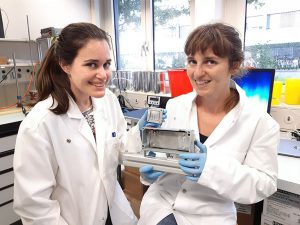From the Journal: Review of Scientific Instruments
WASHINGTON, D.C., October 15, 2019 – Hydrogen-containing substances are important for many industries, but scientists have struggled to obtain detailed images to understand the element’s behavior. In Review of Scientific Instruments, from AIP Publishing, researchers demonstrate the quantification of hydrogen for different states of water — i.e., liquid, frozen and supercooled — for applications to eco-friendly fuel cells.
“Our method is not limited to fuel cells or water. There’s a lot of compounds in the chemical industries, including electrochemistry, electrolytes for batteries or redox flow cells, that also contain hydrogen,” said team leader Pierre Boillat, from the Paul Scherrer Institut in Switzerland.
When pure water is cooled below zero degrees Celsius, it doesn’t always form ice but can remain in a liquid form known as supercooled water. This phenomenon occurs to some extent in polymer electrolyte fuel cells, and as the freezing and subsequent volume expansion of water is known to induce damage, there is interest in understanding these states of water.

CREDIT: Natasa Diklic, PSI
The Swiss team used beams of neutrons to examine the inside of an aluminum-walled calibration cell. Neutrons bounced off the hydrogen of H2O molecules in a detectable pattern, like how X-rays are used to image bones. Boillat’s team previously demonstrated that the differing cross-sections of ice and supercooled water at lower neutron energies could be used for imaging purposes. They have refined the process to produce images with unprecedented contrast.
“We developed a method that uses a high-duty cycle of repetitive pulses that are very broad, giving much stronger beam flux, so that we can measure faster and with better image quality,” said Boillat, describing the so-called high-duty cycle, time-of-flight measurements, which his team implemented at the beamline of the European Spallation Source test setup located at Helmholtz Zentrum Berlin in Germany.
Author Muriel Siegwart explained the increase in measurement speed, from five hours to five minutes, was critical for following a reaction’s progress. She hopes to increase the speed even further, so they can track the formation of ice and subsequent damage within fuel cells.
Boillat highlighted how the team’s cross-continental collaborations were critical to confirm experimental findings. This included collaborations with neutron detector experts at the University of California, Berkeley and theoretical simulation experts at the Neutron Physics Department and Instituto Balseiro in Bariloche, Argentina.
“We observed some impact of the temperature on the measurements but weren’t sure if this was a form of experimental bias. It matched perfectly with the theoretical models proving this was a real effect,” said Boillat.
Boillat’s team was also among the first to experimentally utilize the wavelength frame multiplication chopper system, an enhancement technique that will be included in several instruments at the European Spallation Source facility under construction in Sweden. Leveraging the reference data obtained with this method, the team developed a theoretical framework that optimizes contrast-to-noise ratio in acquired images. The team is applying this framework to the analysis of lithium-ion batteries.
###
For more information:
Larry Frum
media@aip.org
301-209-3090
Article Title
Distinction between super-cooled water and ice with high duty cycle time-of-flight neutron imaging
Authors
Pierre Boillat, Muriel Siegwart, Robin Woracek, Jose Ignacio Marquez Damian, Anton S. Tremsin, Victoria Manzi-Orezzoli, Markus Strobl, Thomas Justus Schmidt
Author Affiliations
Paul Scherrer Institut
